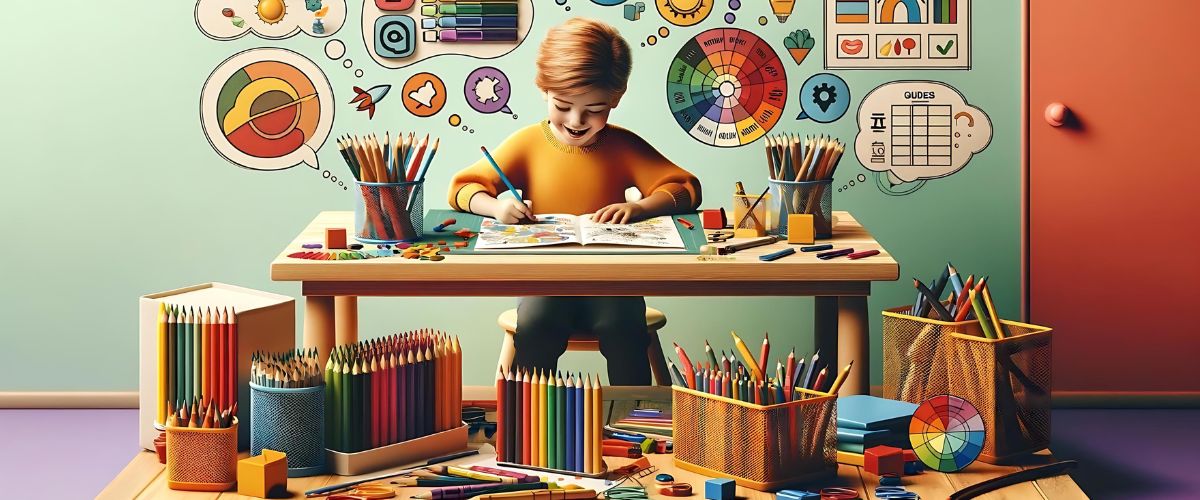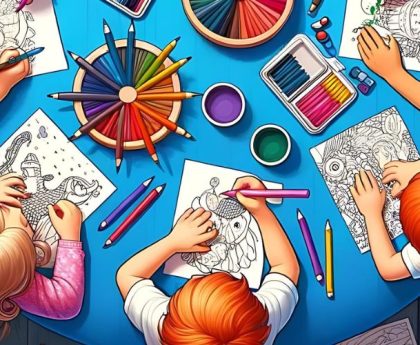Colouring is more than just a fun activity for kids—it’s a developmental tool that can help improve motor skills, creativity, and focus. By offering guidance and introducing structured activities, parents can maximize the benefits of colouring. In this article, we’ll explore some effective strategies and tips that can help children get the most out of their colouring time.
How to Teach Your Child to Colour Within the Lines
Teaching a child to colour within the lines is an essential part of their artistic and motor skill development. This skill not only enhances their fine motor control but also helps them understand spatial boundaries and the importance of precision. Here are detailed steps to help your child master this skill effectively:
Start Simple
Begin the colouring journey with books that feature large images and thick borders. These types of colouring books are specifically designed for younger children or beginners. The large spaces and clear boundaries make it easier for small hands to achieve success without frustration. Opt for simple shapes like big flowers, cars, or basic figures, which don’t require intricate detailing and are forgiving of mistakes.
Show by Example
Children often learn best through observation and imitation. Take the time to sit with your child and engage in colouring alongside them. Choose a similar picture to colour and demonstrate the process. Show them how you stay within the lines, making sure to explain your movements as you go. This visual learning helps the child grasp the concept of boundaries and the techniques used to maintain them.
Guiding Hands
Especially with younger children or those just starting out with colouring, physical guidance can be incredibly helpful. Place your hand over theirs and gently guide their movements as they colour. This not only helps them feel the correct way to move the crayon or pencil but also provides comforting physical reassurance. This method also allows you to directly influence their pressure control and speed, crucial aspects of colouring within the lines.
Discuss Techniques
As you colour together, discuss and demonstrate specific techniques that enhance colouring skills:
- Slow and Steady Teach them that slow, deliberate movements are more likely to stay within the lines than quick, sweeping strokes.
- Section by Section Encourage colouring in small sections at a time, which can prevent them from feeling overwhelmed and helps maintain focus on the area at hand.
- Directional Colouring Show them how colouring in one direction can help maintain consistency and neatness.
Praise Efforts
Focus on the process rather than the final product. Praise your child for their effort, determination, and persistence. Celebrate their attempts to stay within the lines, even if the outcome isn’t perfect. Positive reinforcement in this way helps build their confidence and encourages them to continue practicing. Statements like, “I love how carefully you’re colouring,” or “You’re doing a great job taking your time,” reinforce the value of their effort.
Summary of colouring withing the lines
By following these steps, you can effectively support your child’s development in colouring within the lines. This skill is not just about art; it’s about motor development, patience, and learning to handle tasks with care. As they improve, gradually introduce more complex images to keep them challenged and engaged, ensuring a continuous and rewarding learning curve.
Colour Theory for Kids
Introducing basic colour theory can be a fascinating and educational aspect of colouring for children. Here are some concepts to explore:
- Primary Colours: Teach them about primary colours (red, blue, and yellow) and how they can be mixed to create secondary colours.
- Warm and Cool Colours: Explain the difference between warm colours (like red and yellow) and cool colours (such as blue and green), and how they can affect the mood of their artwork.
- Colour Mixing: Use watercolour paints along with colouring to show how different colours mix to form new ones. This can be a fun and messy activity that deepens their understanding of colour.
Projects and Activities Using Colouring Books
Colouring books can be the starting point for various creative projects and learning activities:
- Themed Art Projects: Pick a theme each week, such as underwater scenes or forest animals, and let them colour pages that fit the theme. This can culminate in a mini-exhibition of their coloured pages.
- Colouring Competitions: Organize a colouring competition where they can colour a page and then explain their artwork to the family, helping develop their verbal skills along with their artistic ones.
- Storytelling with Pictures: Encourage them to create a story based around the pictures they have coloured. This not only utilizes their colouring but also stimulates their imagination and narrative skills.
Conclusion
Through these guides and tips, colouring can become a more educational and enriching experience for children. By teaching them to colour within the lines, introducing them to colour theory, and incorporating colouring into broader projects and activities, you help develop their artistic skills, cognitive abilities, and love for learning. Engage actively in your child’s colouring activities to make the most of this versatile educational tool, fostering a creative and colourful journey of growth.





